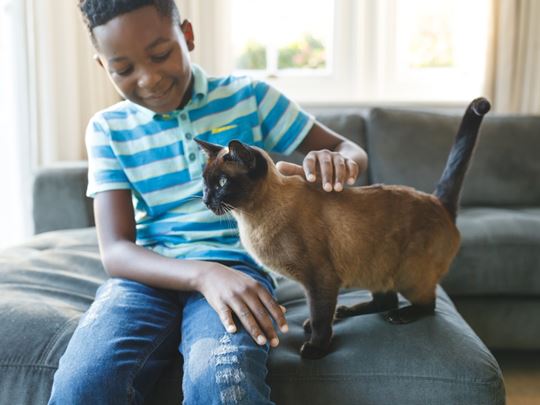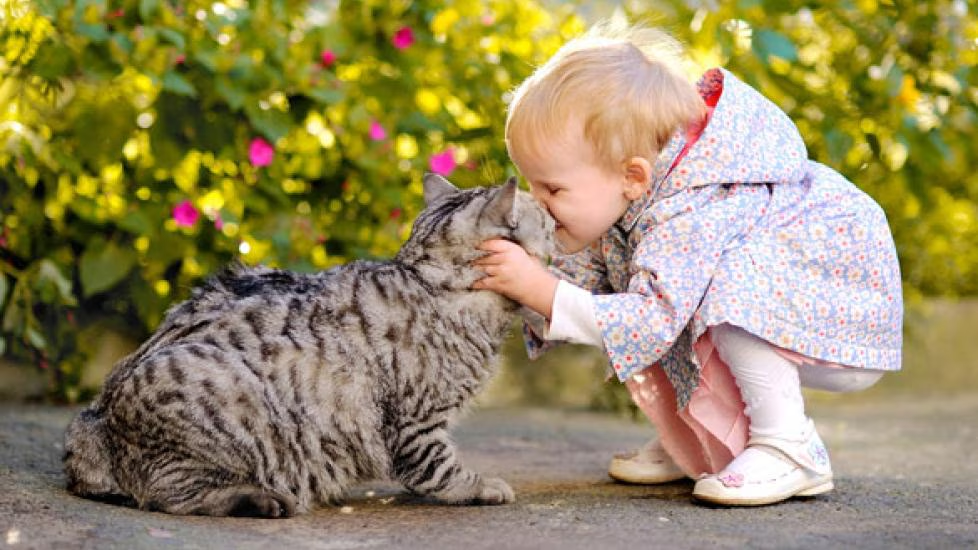🐾 How to Talk to Kids About Caring for Cats & Kittens
By Katie – The Kitten Cradle
A volunteer once shared a touching story about her young daughter, Emma. When their family adopted a shy gray kitten named Sugar, they weren’t sure how the kitten would react to a busy household. But Emma—only five at the time—instinctively gave Sugar space, spoke gently, and helped refill her water bowl every morning. Over time, Sugar warmed up to her, curling up on Emma’s pillow at night. Their bond became inseparable. What struck me the most was how naturally Emma learned empathy and responsibility, just by being included in Sugar’s daily care.
This story is a reminder that kids don’t just love animals—they can learn from them, too.

❤️ Why It’s Important to Involve Kids in Pet Care
When children are invited to help care for a pet, they gain far more than just another chore. They begin to understand how their actions impact others—both emotionally and physically. Helping feed a kitten or gently brushing a cat teaches children that living things rely on them. This sense of responsibility builds confidence and fosters empathy.
Pet care can also be a positive outlet for kids’ energy and curiosity. With the right guidance, a child can develop a lasting sense of compassion, patience, and self-control—qualities that will benefit them in all areas of life.
🛑 Cat Safety 101: Teaching Gentle Handling and Boundaries
Cats, especially kittens, are delicate and sensitive. Teaching children how to safely and respectfully interact with them is the first step to building trust between child and pet.
Make sure children understand that:
- Cats are not toys—they can feel fear and pain.
- You should always let the cat come to you.
- Pulling tails, ears, or whiskers is never okay.
- Cats need quiet time to sleep, eat, and use the litter box.
- If a cat hisses, hides, or swipes, it’s their way of saying, “I need space.”
Encourage your child to pay attention to the cat’s body language and to use soft voices and slow movements. When both the cat and child feel safe, their bond can flourish.

👶👧👦 Age-Appropriate Cat Care Tasks for Kids
Ages 2–4: Learning Through Observation & Gentle Touch
- Practice gentle petting with supervision
- Learn names of body parts (tail, whiskers, paws)
- Help carry toys or small treats
- Practice “quiet time” around sleeping cats
Ages 5–7: Introducing Simple Responsibilities
- Refill food and water bowls (with supervision)
- Use toys to play appropriately (like wand toys)
- Brush the cat gently with a soft brush
- Help clean up toys or bedding
Ages 8–10: Building Daily Routines
- Measure and serve food independently
- Clean the litter box with guidance
- Track medication or feeding schedules
- Help choose supplies at the pet store
- Assist in grooming or nail trimming (with adult)
Ages 11+: Taking Full Ownership of Tasks
- Feed and care for cat independently
- Monitor health and behavior changes
- Set reminders for vet appointments or flea prevention
- Help socialize shy kittens with proper technique
- Volunteer (with a parent) at a local shelter or event

✅ DOs and ❌ DON’Ts for Kids and Cats
DO:
- Approach cats slowly and calmly
- Use toys instead of hands for play
- Let the cat walk away without chasing
- Be gentle with touch and voice
- Tell an adult if the cat seems hurt or upset
DON’T:
- Pick up or carry the cat without asking
- Pull tails, ears, or whiskers
- Yell, chase, or corner the cat
- Disturb cats while sleeping or eating
- Forget to wash hands after cleaning or petting
🧡 Final Thoughts
Cats and kittens have a lot to teach us—and children are especially good students when given the chance. By modeling safe and loving care, you’re not only helping a child build a bond with an animal—you’re also shaping a more empathetic, responsible person.
At The Kitten Cradle, we’ve seen firsthand how impactful these relationships can be. With patience, guidance, and a little fur on the furniture, your child can grow alongside a feline friend in the most meaningful way.


